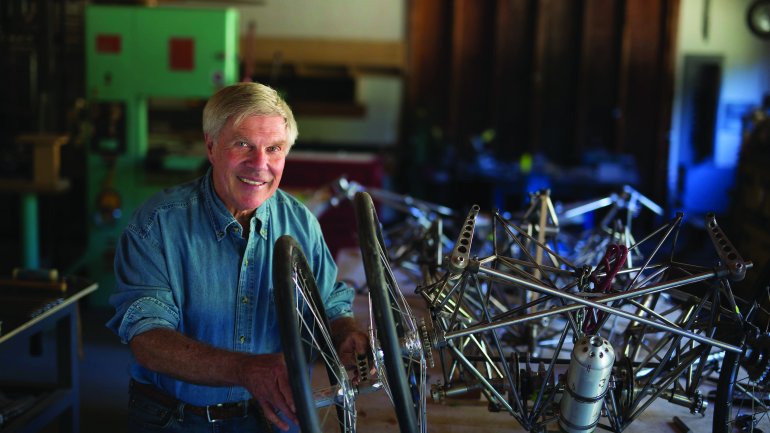Masters: Michael Cooper
Masters: Michael Cooper
Some artists trace their path to childhood; they talk of growing up surrounded by fine-art influences. Not Michael Cooper. “I grew up in a small town,” he says, “and that just wasn’t part of our daily life.” What he did have – in spades – was exposure to craft, learning to work wood at his grandfather’s cabinetmaking shop. Perhaps it freed him; Cooper is among the most distinctive, imaginative sculptors of his generation.
Sculpture clicked for him in the late 1960s. He’d just earned a degree in commercial art from San Jose State when Fletcher Benton joined the faculty. The rising star had work in “American Sculpture of the Sixties” at the Los Angeles County Museum of Art, and a friend loaned Cooper the airfare. The variety, the craftsmanship: “It captured your imagination in ways that you couldn’t even predict,” he recalls. He knew it, right then. “That’s what I want to do.”
Cooper stayed at San Jose, earning an MA in sculpture, and went on to an MFA at the University of California, Berkeley. “I really had no idea how I was going to make a living,” he says wryly. “And thank God, it all worked out.”
It’s easy to get lost in the fantastical nature of his work: How the West Was Won, How the West Was Lost (1977 – 2011) is a giant kinetic sculpture, featuring an oversized boot and oil derrick. Or their poignancy: Trainer Tricycle (1993) reimagines the vehicle’s frame as a revolver. Impeccably crafted, they appear to have sprung directly from his imagination; that Cooper also makes these objects, moving fluidly among mediums, as much engineer and architect as artist, boggles the mind.
Cooper is more modest. “The thing about making is this is my way of communicating. I don’t think of myself as a speaker. I don’t think of myself as skilled in any other way. This is my area to be real and contribute.”
Career highlights: Cooper had his first major solo show at the Museum of Modern Art in San Francisco in 1977. In 2013, a traveling retrospective organized by the city’s Museum of Craft and Design, titled “Michael Cooper: A Sculptural Odyssey, 1968 – 2011,” bookended that accomplishment.
On craftsmanship: In 1979, Cooper and his wife, Gayle, took a cross-country trip, visiting schools with wood programs with a focus on furniture or sculpture. “I realized I related much more to craftsmen,” Cooper says. “We were in tune with the same sorts of concerns, I guess, from a craft point of view, from a making point of view – and using the tools. I respect tools. I love tools.”
On beginning: “Early on, you’re trying to learn who you are. You’ve got to find out who you are – what you are about, what makes you different, and what seems real and honest from your point of view.”
Making it: “Success is: I can come into the studio and feel confident that I’m where I ought to be. I’m doing what I should be doing. I’m using the materials. And I’ve got the skills and I’ve still got the interest to explore.”
Read more about the 2016 American Craft Council Awards and winners.

